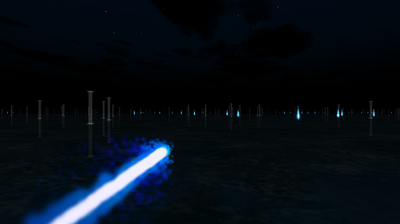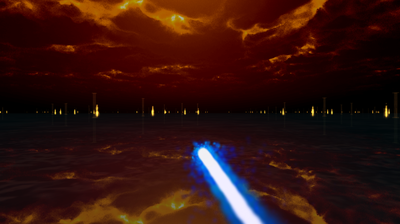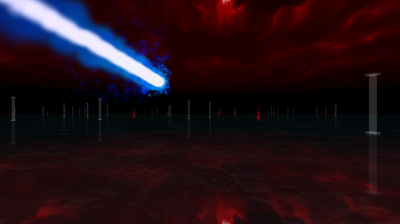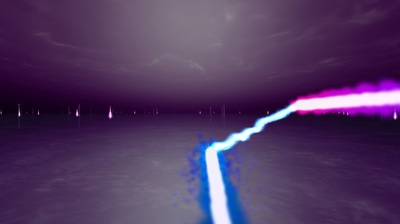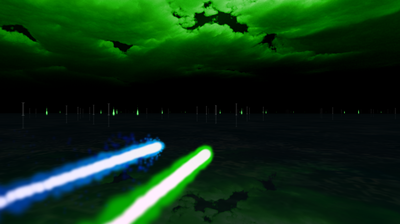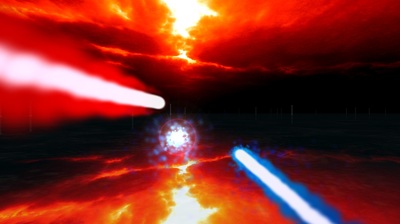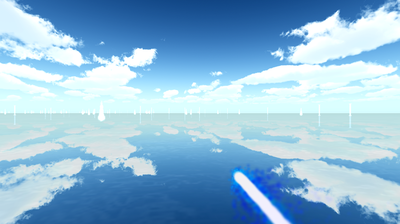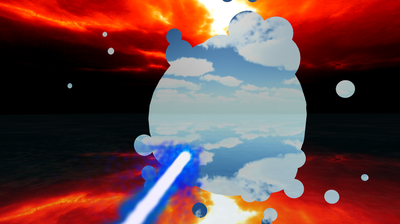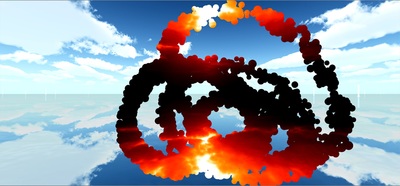Created by Chris Beagle, Sawyer Paradise, and Kenneth Zuerner.
One-semester, junior-year game project. Made in Unity.
My contributions to the project included:
- Design of the theme, each level's mechanics, and each level's aesthetic.
- Implementation of procedural generation of obstacles and pick-ups.
- Implementation of most of the level mechanics, including the Envy wisp's AI.
- Implementation of each level's aesthetic, including joint-effort implementation of the portal VFX.
Below is the trailer I made for Will-o'. Music by Thornton Prime.
One-semester, junior-year game project. Made in Unity.
My contributions to the project included:
- Design of the theme, each level's mechanics, and each level's aesthetic.
- Implementation of procedural generation of obstacles and pick-ups.
- Implementation of most of the level mechanics, including the Envy wisp's AI.
- Implementation of each level's aesthetic, including joint-effort implementation of the portal VFX.
Below is the trailer I made for Will-o'. Music by Thornton Prime.
Will-o' was inspired by Race The Sun, though I wasn't the one who was inspired by this gameplay - I was the one who took the gameplay the team had chosen and tried to make it inspiring through its theme, its mechanics, and its visuals. What I came up with was a game in which the player played as a wisp, a lost soul, exploring the stages of Purgatory as represented by the seven deadly sins, each sin reflected as a playable level, unique both visually and mechanically. Ultimately, we didn't have time to fully-implement what I'd envisioned, never introducing the obstacle variety nor the explicit story arc, but I'm pleased with what we ended up with, even so.
Sloth is the first level. Its unique mechanic is that the player slows down over time and has to collect powerups to keep up their speed, however, since progress can be made simply based on time, collecting powerups is actually completely optional. While keeping speed is more interesting, it is also more difficult - being lazy is easier, and safer, enticing the player towards the sin. Sloth's visuals are dim and cold to reflect the melancholy of being unmotivated.
Greed is the second level. Its unique mechanic is actually found in its procedural generation; unlike other levels, which spawn powerups and obstacles independently of each other, Greed's generation ensures that every powerup is spawned near an obstacle. The player can simply avoid everything, and progress based on time, but if they want to collect powerups, they have to be at least a little greedy - none of the powerups are easy to collect safely. Greed's visuals are gold and black with high contrast to be reminiscent of both wealth and darkness.
Gluttony is the third level. Its unique mechanic is that the more powerups the player collects, the more objects the procedural generation pumps out - both powerups and obstacles. Again, players are incentivized to indulge in the sin to progress more quickly, but have the option of playing it safe and progressing based on time. Gluttony's visuals are deep red, and dark, giving the environment an almost flesh-like appearance.
Lust is the fourth level. Its unique mechanic is that the player has a companion wisp who speeds up the player's progress if the player stays within a certain proximity of it. However, this companion wisp actively avoids the player, so if the player wants to maintain the link, they have to chase it - often at the expense of not paying as much attention as they should to obstacles and powerups. Again, the player is tempted to pursue the sin at their own risk. Lust's visuals are a soft purple with an uneventful skybox to set a gentler mood, especially in contrast to previous levels, and introduces new background music to accentuate this change as well.
Envy is the fifth level. Its unique mechanic is that it features a companion wisp who attempts to steal powerups from the player, causing the player frustration and, ideally, some degree of envy - assuming the player is trying to collect the powerups for themselves, that is - as always, the player has the option to simply progress based on time. Envy's visuals are green and high contrast with a mixture of harsh darks and bright, almost neon accents, the green simply because of common association, the mood because of the level's competitive nature.
Wrath is the sixth level. Its unique mechanic is that it has no powerups available, but instead features a host of other wisps that the player can kill to progress more quickly. These wisps attempt to avoid the player, helping to ensure that any deaths are intentional, and audibly cry out when destroyed in a voice that sounds disturbingly human - many players, even those who had been sinning freely the entire playthrough, are given pause by the screams of the wisps they kill. Wrath's visuals are fiery, with vivid oranges, bright reds, and black - high contrast and pointedly more dramatic than the aesthetics of other levels. Wrath also introduces bold new background music that helps set the tone and spike the engagement even further.
Pride is the seventh level. Its unique mechanic is a matter of pitting pride against progress, and manifests in two ways: first, every powerup the player collects increases their speed, making the level more intense, and more fun, but also more difficult; second, the visuals themselves make it hard to see what's coming, making powerups harder to collect and obstacles harder to avoid - a play off the adage "blinded by pride" - the environment itself is both beautiful and detrimental. The aesthetic for Pride is one of almost heavenly brilliance, featuring bright whites, sapphire blues, and sky that looks refreshingly normal - like a cool summer day rather than the bowels of Purgatory.
Upon completing Pride, the player finds themselves back in Sloth, told that they cannot escape the sins of their past.
The portal VFX featured in Will-o' were inspired by the legendary greatsword "Sunrise" from Guild Wars 2. Although I was the one originally enamored by Sunrise's VFX, my inspiration became shared by Sawyer Paradise, who teamed up with me to implement the portals seen in Will-o'. I later adapted the portal VFX even further, using it to create some stunning illusions in snow - something I couldn't have done without the knowledge I'd gained from Will-o'.
Sloth is the first level. Its unique mechanic is that the player slows down over time and has to collect powerups to keep up their speed, however, since progress can be made simply based on time, collecting powerups is actually completely optional. While keeping speed is more interesting, it is also more difficult - being lazy is easier, and safer, enticing the player towards the sin. Sloth's visuals are dim and cold to reflect the melancholy of being unmotivated.
Greed is the second level. Its unique mechanic is actually found in its procedural generation; unlike other levels, which spawn powerups and obstacles independently of each other, Greed's generation ensures that every powerup is spawned near an obstacle. The player can simply avoid everything, and progress based on time, but if they want to collect powerups, they have to be at least a little greedy - none of the powerups are easy to collect safely. Greed's visuals are gold and black with high contrast to be reminiscent of both wealth and darkness.
Gluttony is the third level. Its unique mechanic is that the more powerups the player collects, the more objects the procedural generation pumps out - both powerups and obstacles. Again, players are incentivized to indulge in the sin to progress more quickly, but have the option of playing it safe and progressing based on time. Gluttony's visuals are deep red, and dark, giving the environment an almost flesh-like appearance.
Lust is the fourth level. Its unique mechanic is that the player has a companion wisp who speeds up the player's progress if the player stays within a certain proximity of it. However, this companion wisp actively avoids the player, so if the player wants to maintain the link, they have to chase it - often at the expense of not paying as much attention as they should to obstacles and powerups. Again, the player is tempted to pursue the sin at their own risk. Lust's visuals are a soft purple with an uneventful skybox to set a gentler mood, especially in contrast to previous levels, and introduces new background music to accentuate this change as well.
Envy is the fifth level. Its unique mechanic is that it features a companion wisp who attempts to steal powerups from the player, causing the player frustration and, ideally, some degree of envy - assuming the player is trying to collect the powerups for themselves, that is - as always, the player has the option to simply progress based on time. Envy's visuals are green and high contrast with a mixture of harsh darks and bright, almost neon accents, the green simply because of common association, the mood because of the level's competitive nature.
Wrath is the sixth level. Its unique mechanic is that it has no powerups available, but instead features a host of other wisps that the player can kill to progress more quickly. These wisps attempt to avoid the player, helping to ensure that any deaths are intentional, and audibly cry out when destroyed in a voice that sounds disturbingly human - many players, even those who had been sinning freely the entire playthrough, are given pause by the screams of the wisps they kill. Wrath's visuals are fiery, with vivid oranges, bright reds, and black - high contrast and pointedly more dramatic than the aesthetics of other levels. Wrath also introduces bold new background music that helps set the tone and spike the engagement even further.
Pride is the seventh level. Its unique mechanic is a matter of pitting pride against progress, and manifests in two ways: first, every powerup the player collects increases their speed, making the level more intense, and more fun, but also more difficult; second, the visuals themselves make it hard to see what's coming, making powerups harder to collect and obstacles harder to avoid - a play off the adage "blinded by pride" - the environment itself is both beautiful and detrimental. The aesthetic for Pride is one of almost heavenly brilliance, featuring bright whites, sapphire blues, and sky that looks refreshingly normal - like a cool summer day rather than the bowels of Purgatory.
Upon completing Pride, the player finds themselves back in Sloth, told that they cannot escape the sins of their past.
The portal VFX featured in Will-o' were inspired by the legendary greatsword "Sunrise" from Guild Wars 2. Although I was the one originally enamored by Sunrise's VFX, my inspiration became shared by Sawyer Paradise, who teamed up with me to implement the portals seen in Will-o'. I later adapted the portal VFX even further, using it to create some stunning illusions in snow - something I couldn't have done without the knowledge I'd gained from Will-o'.
